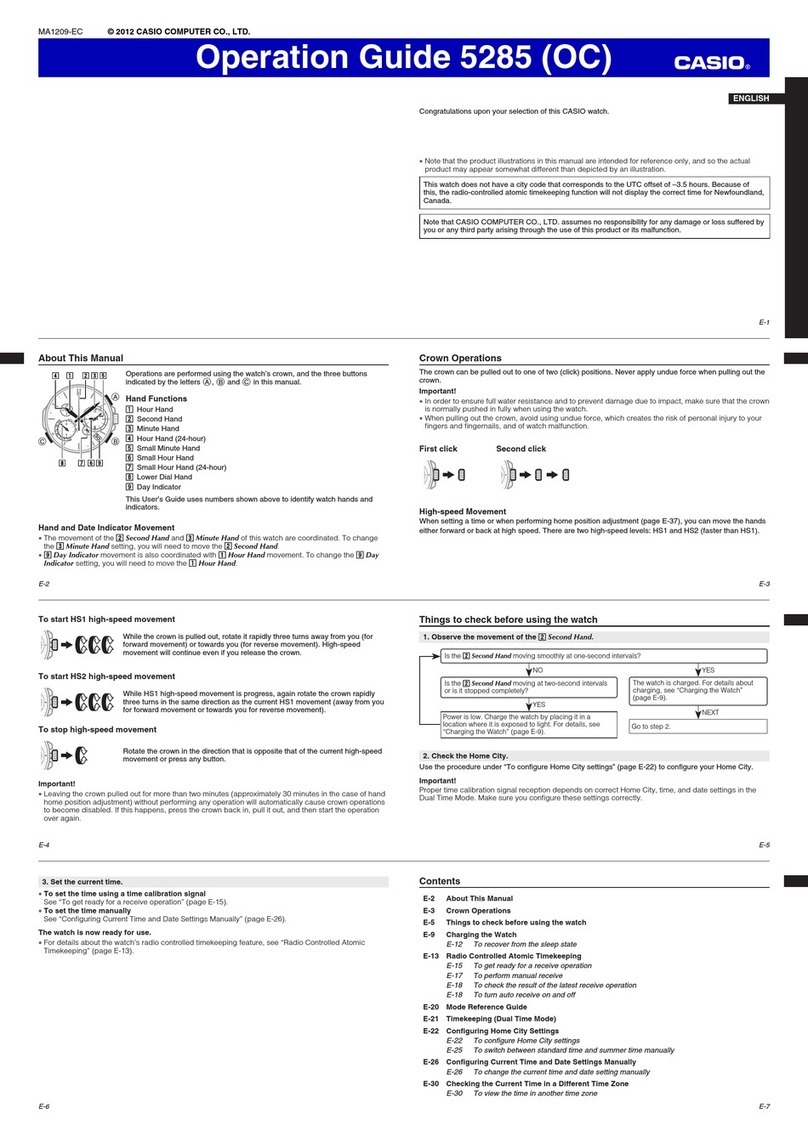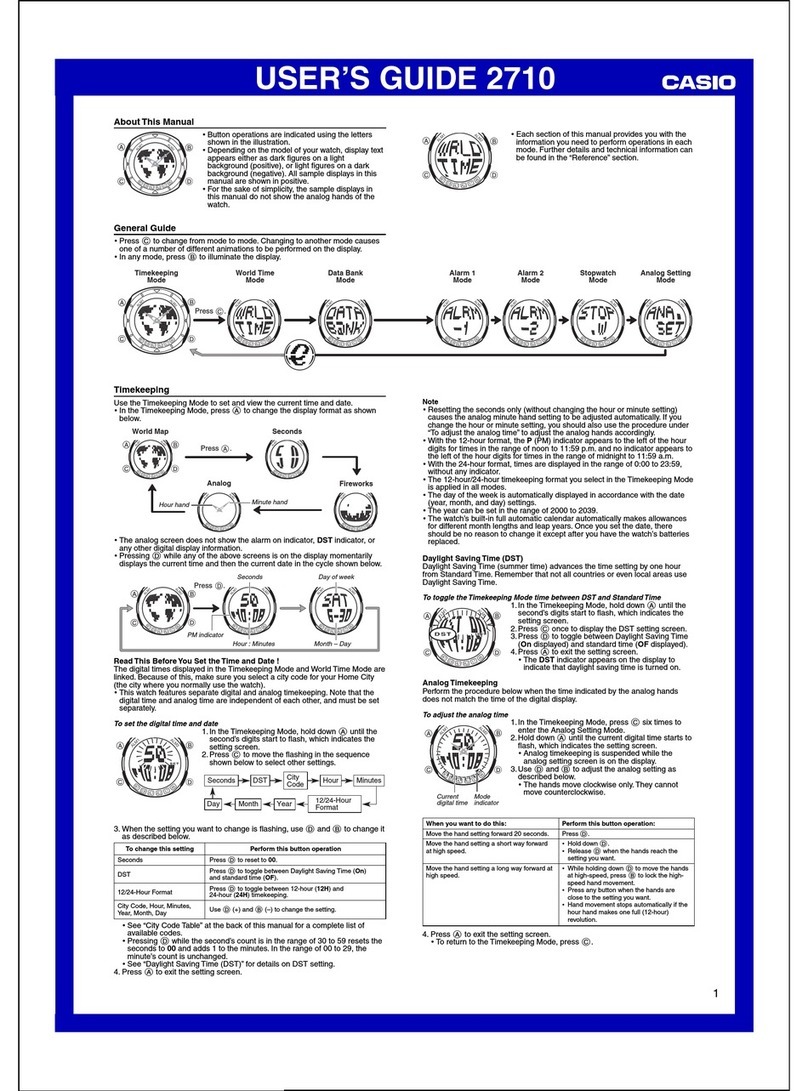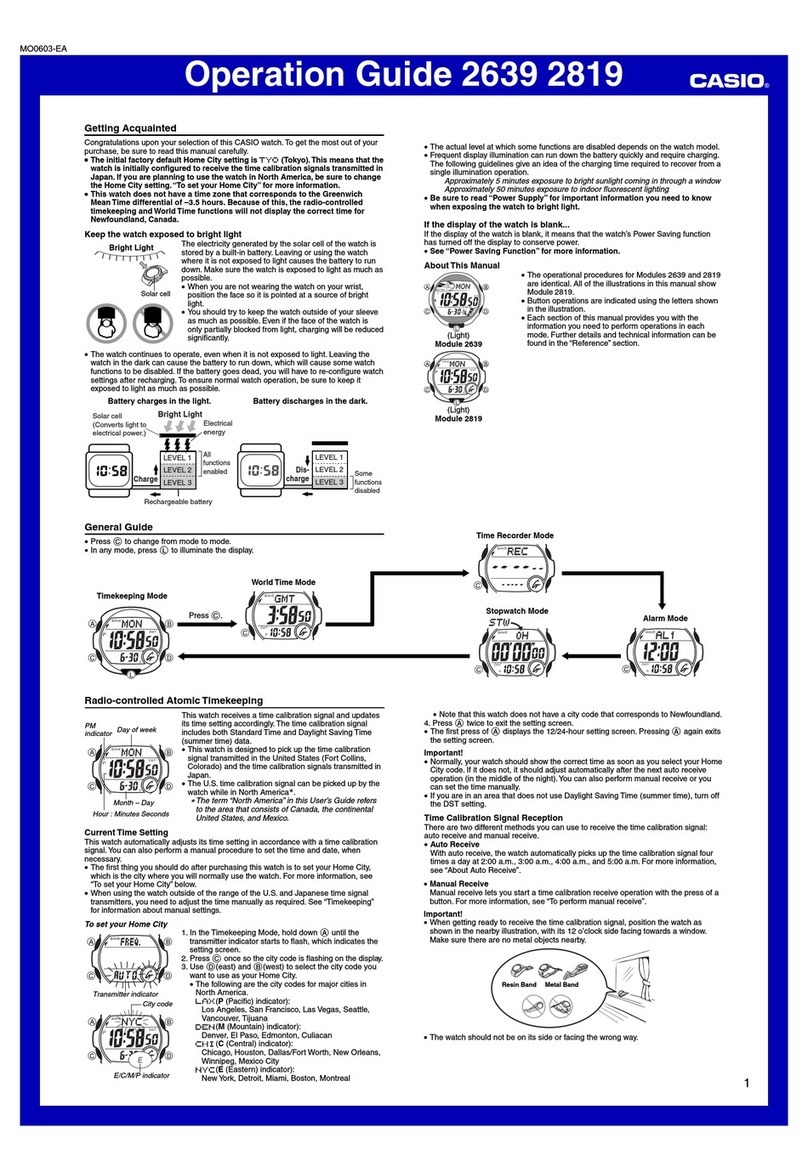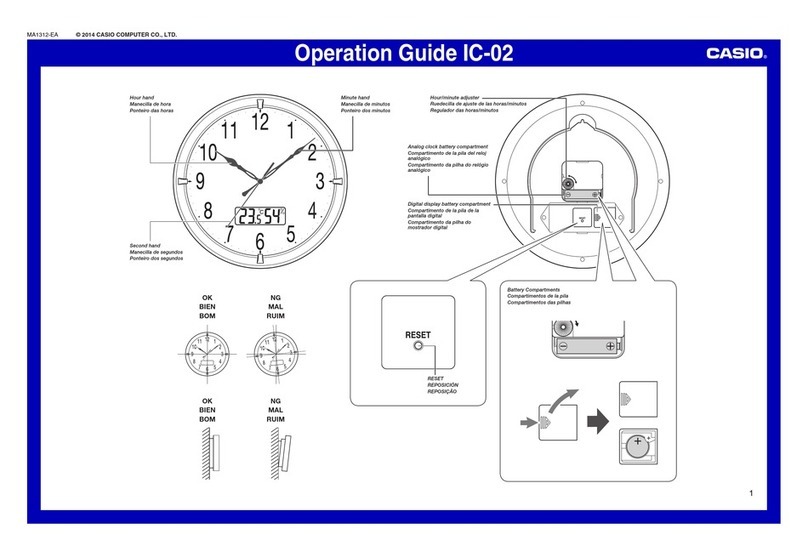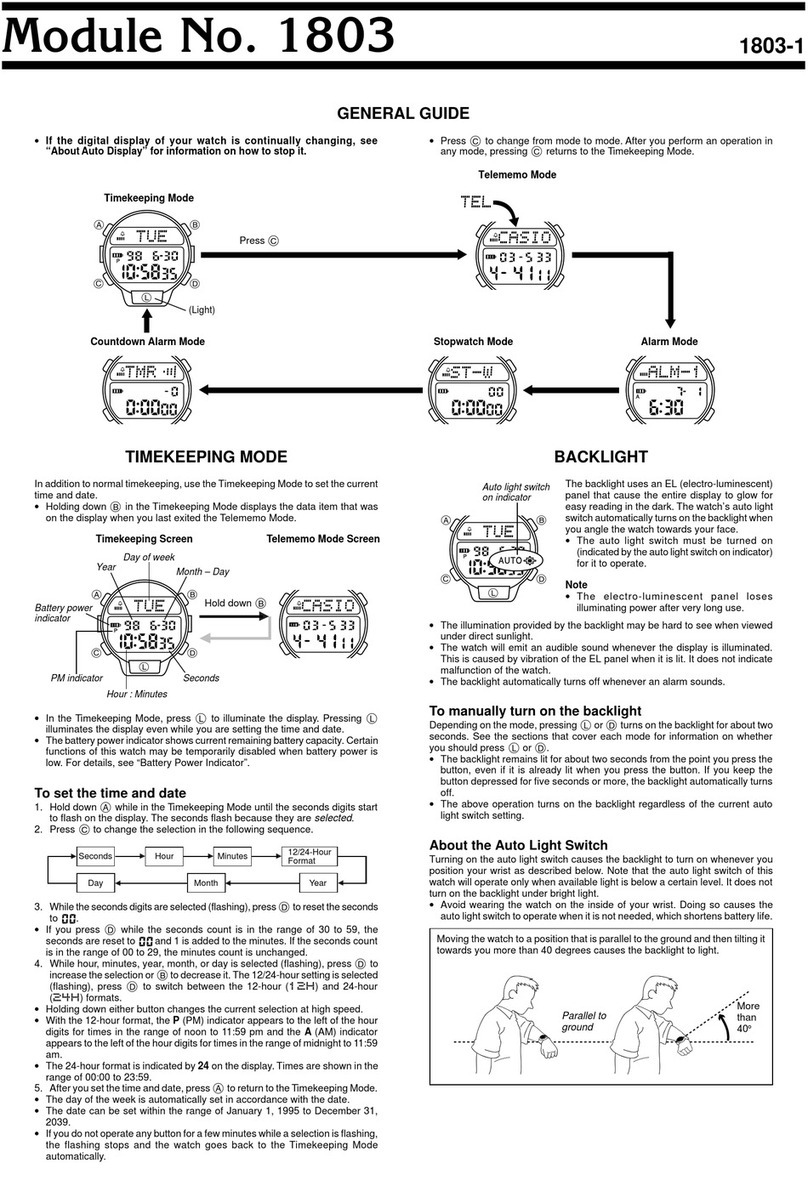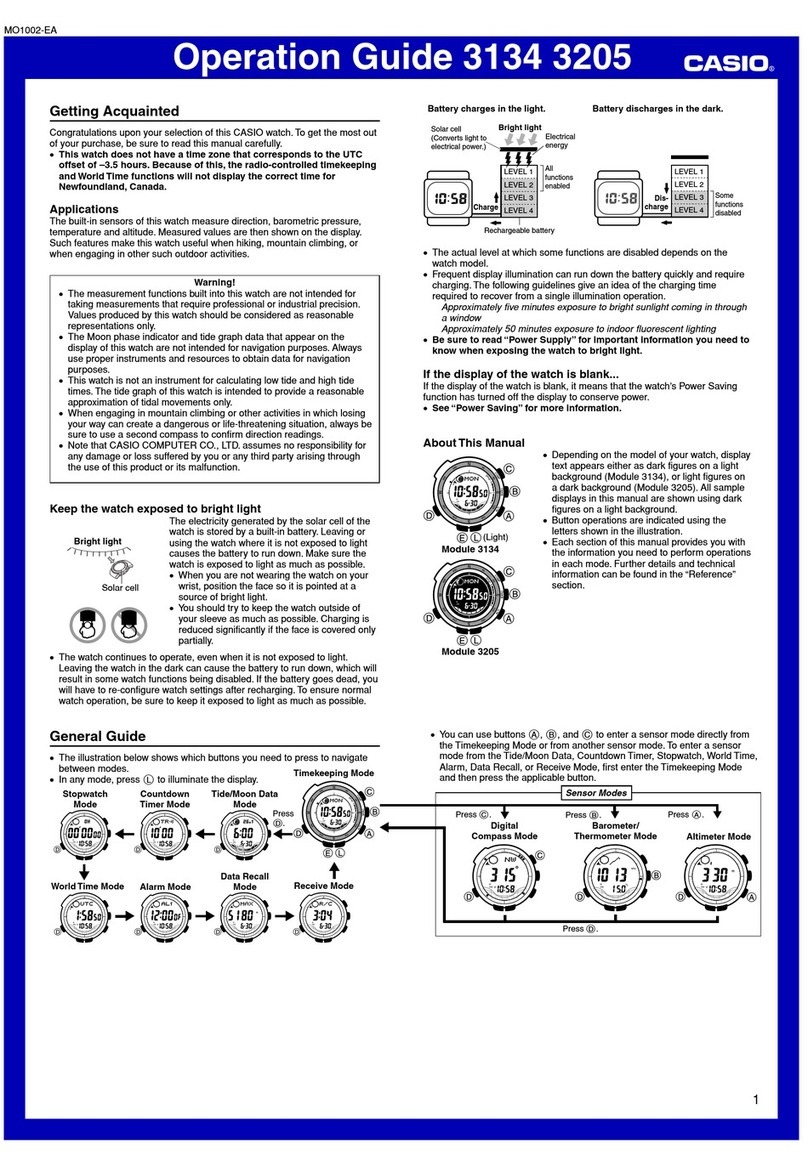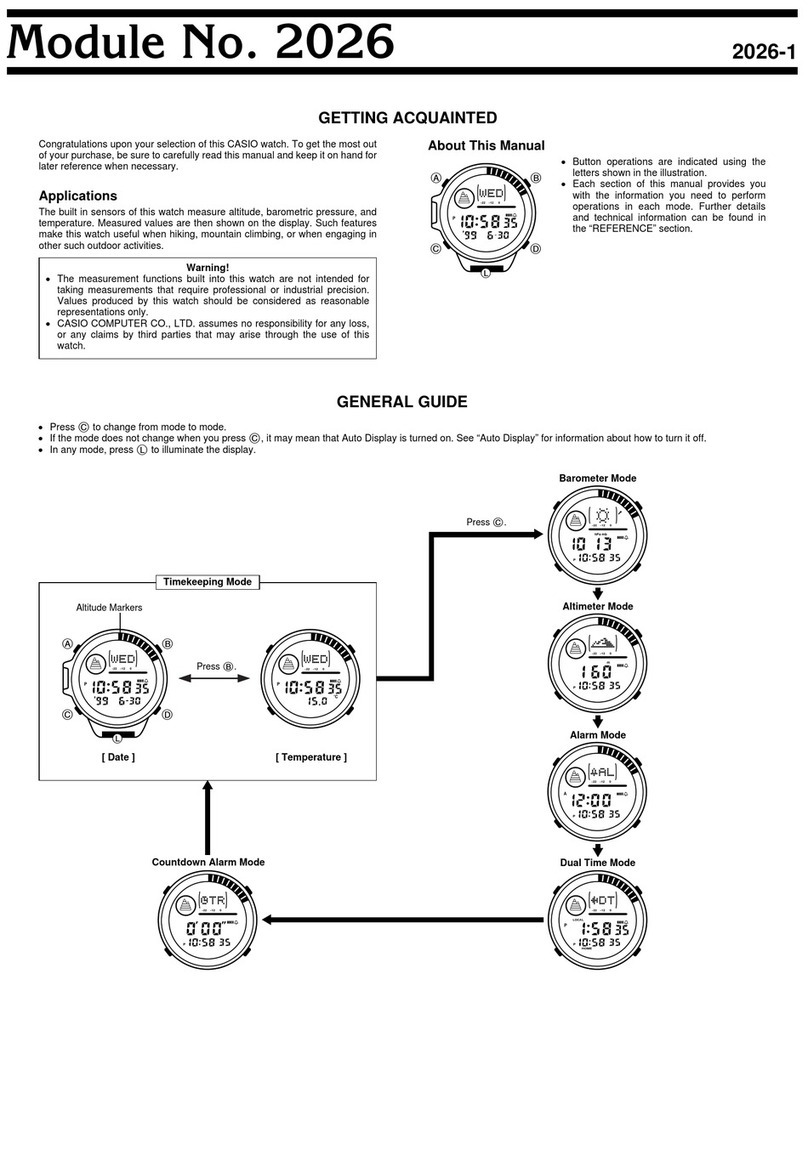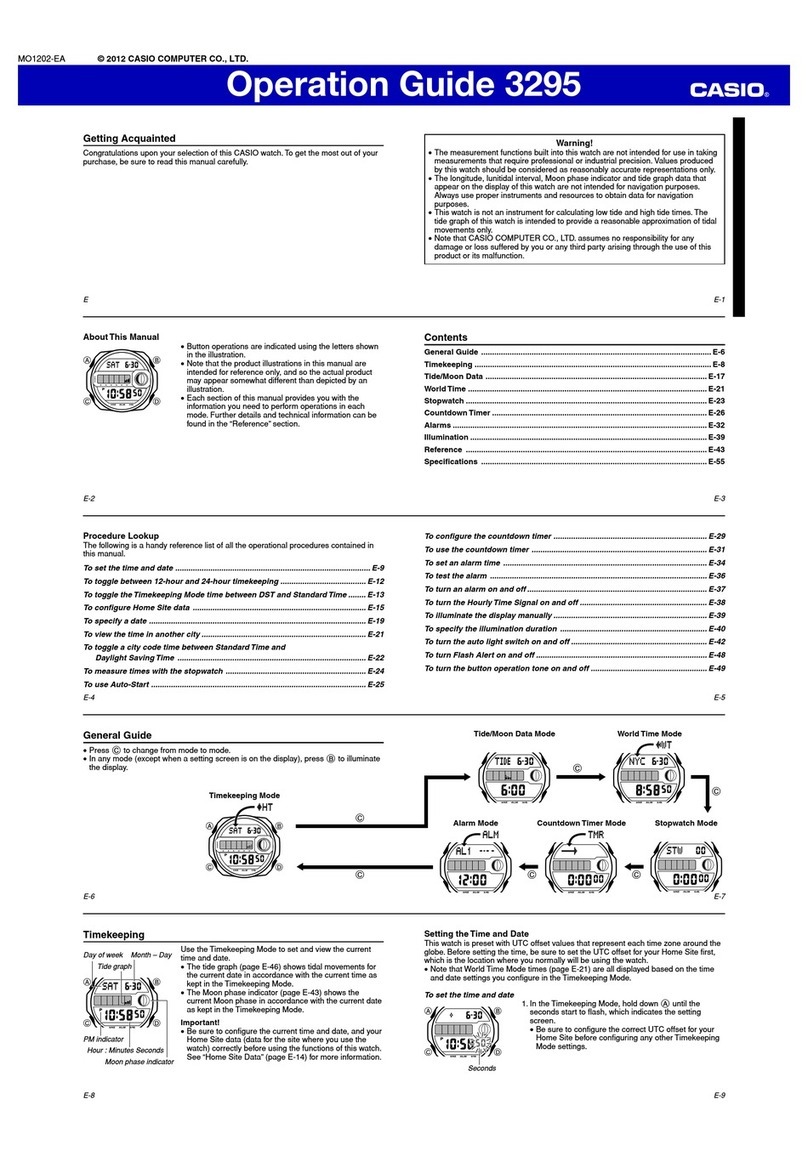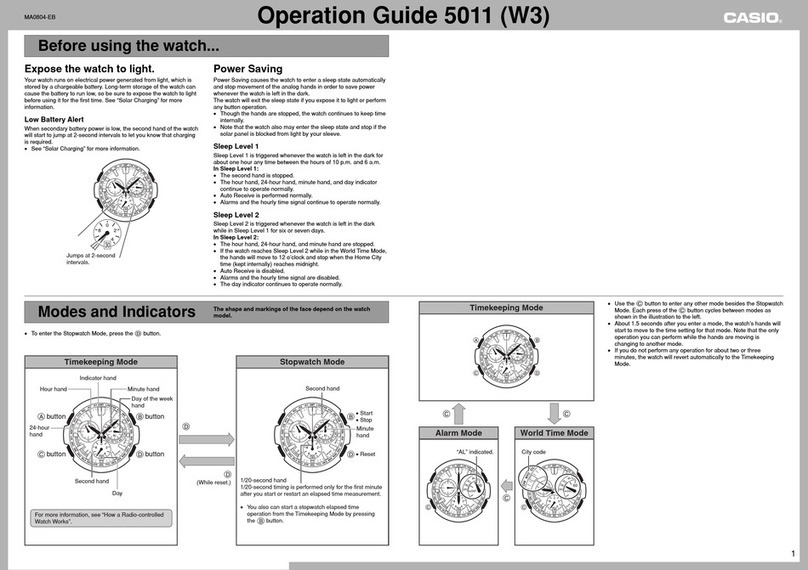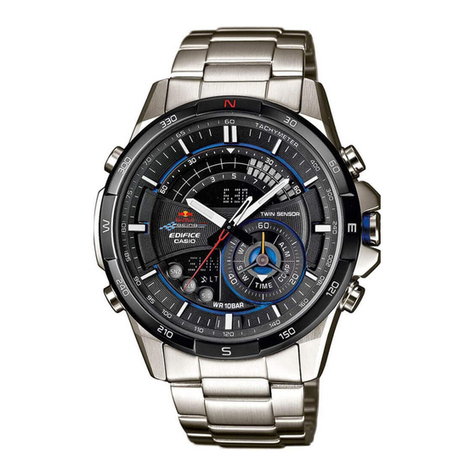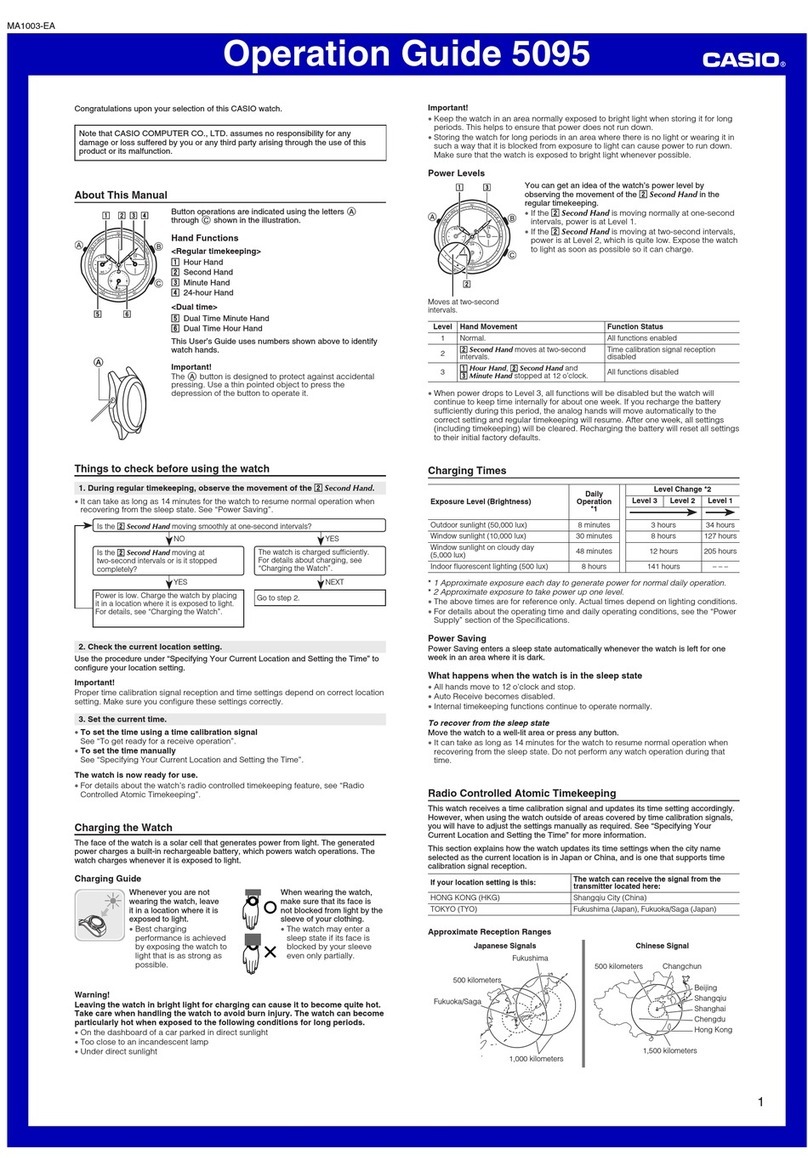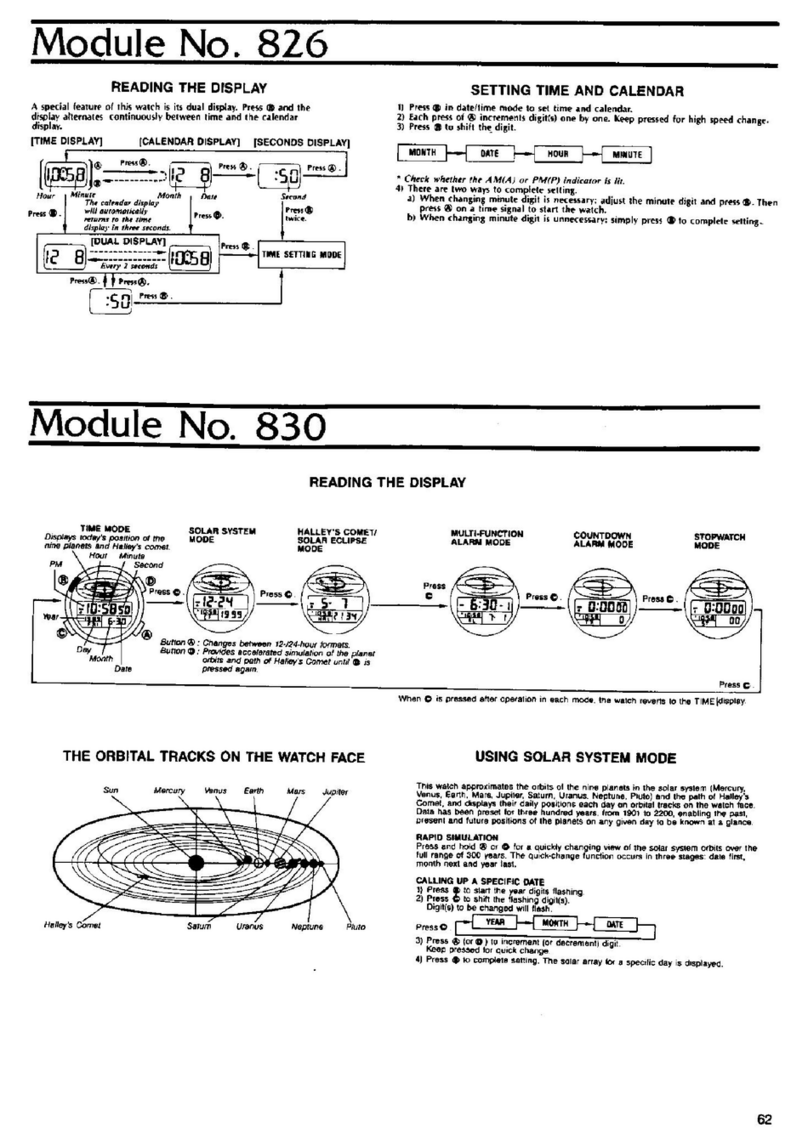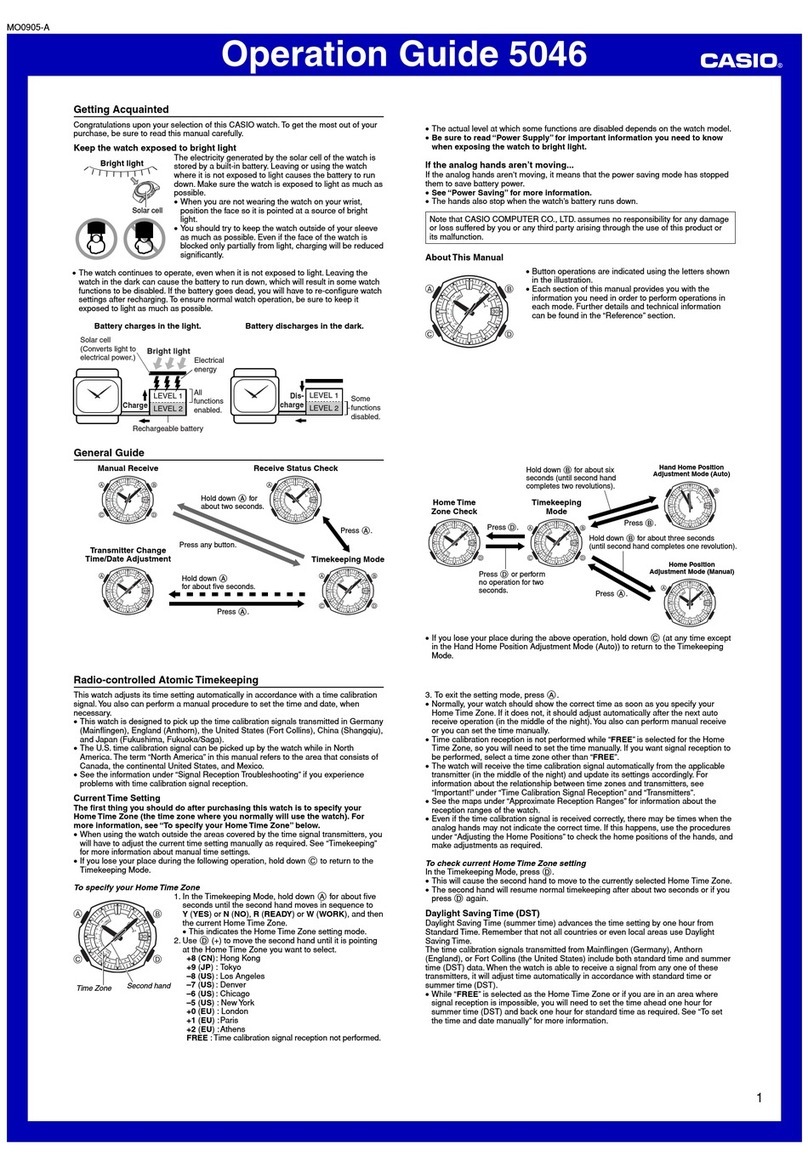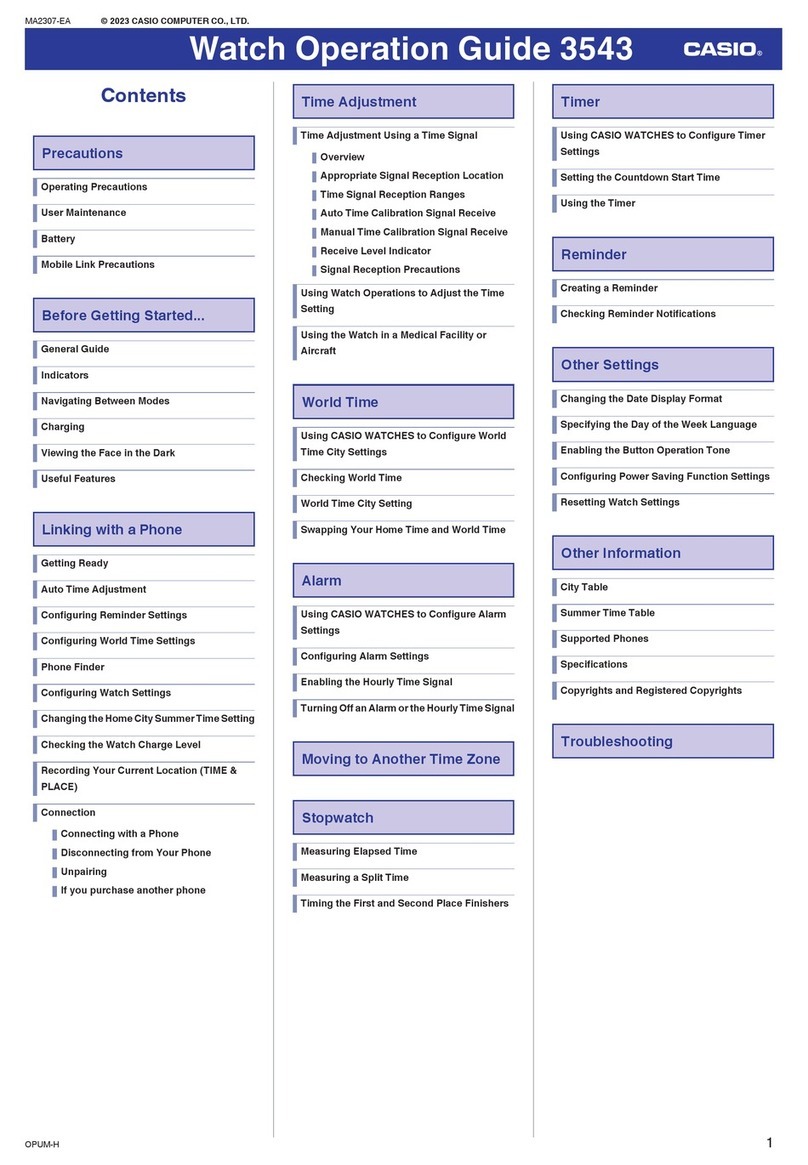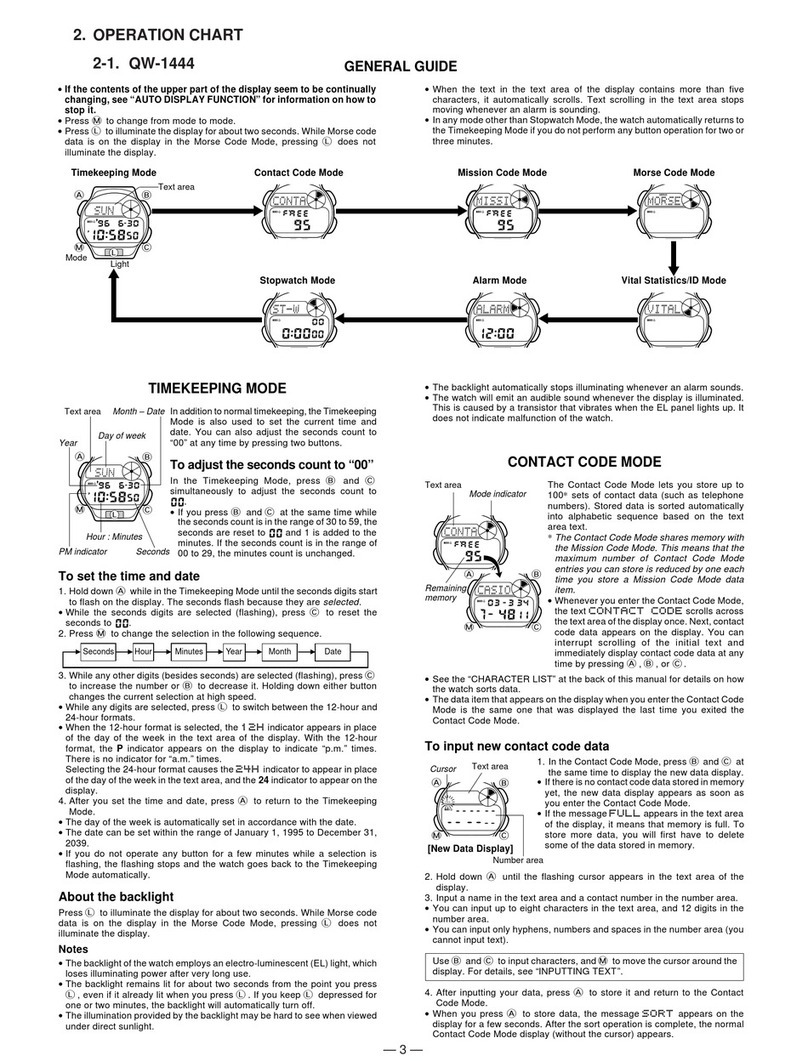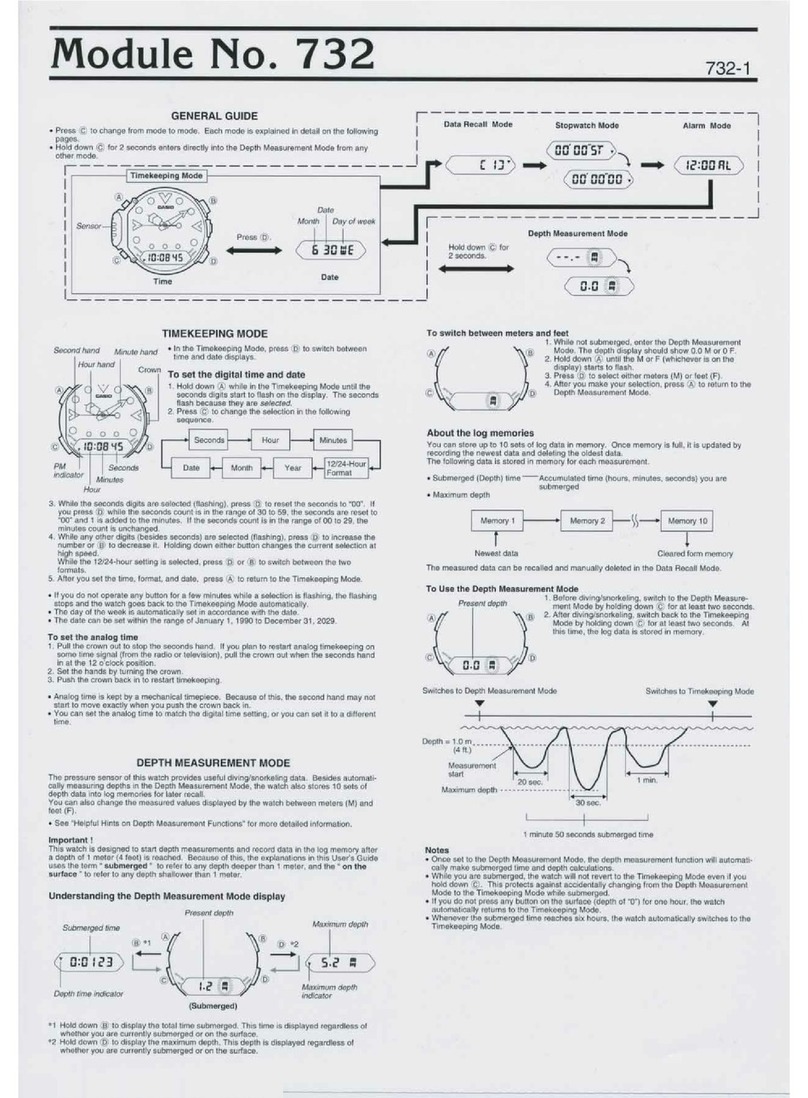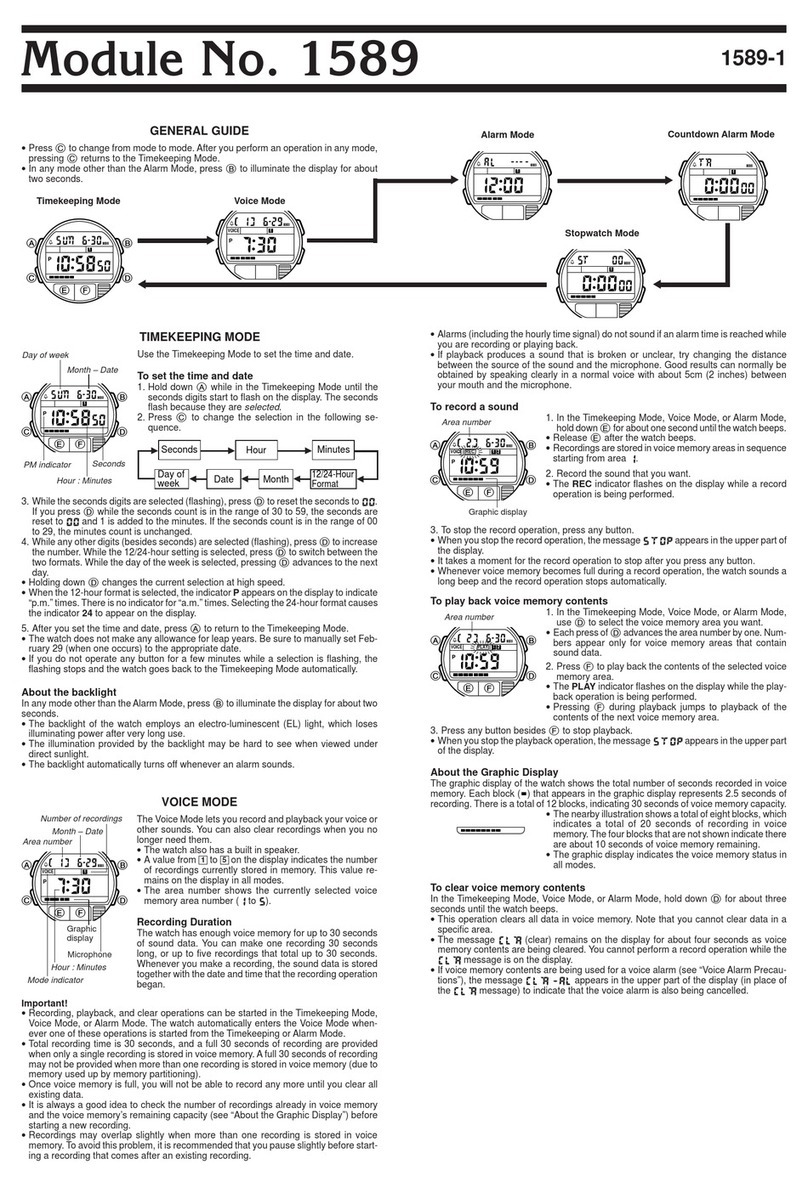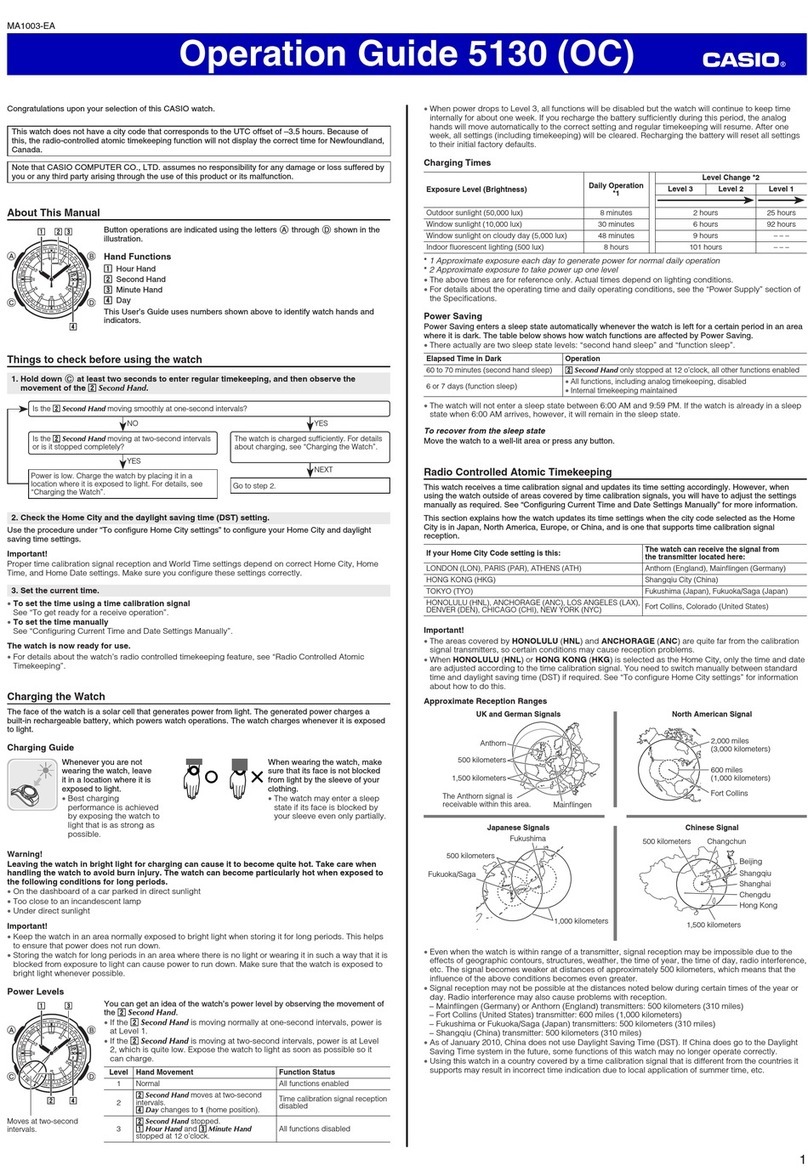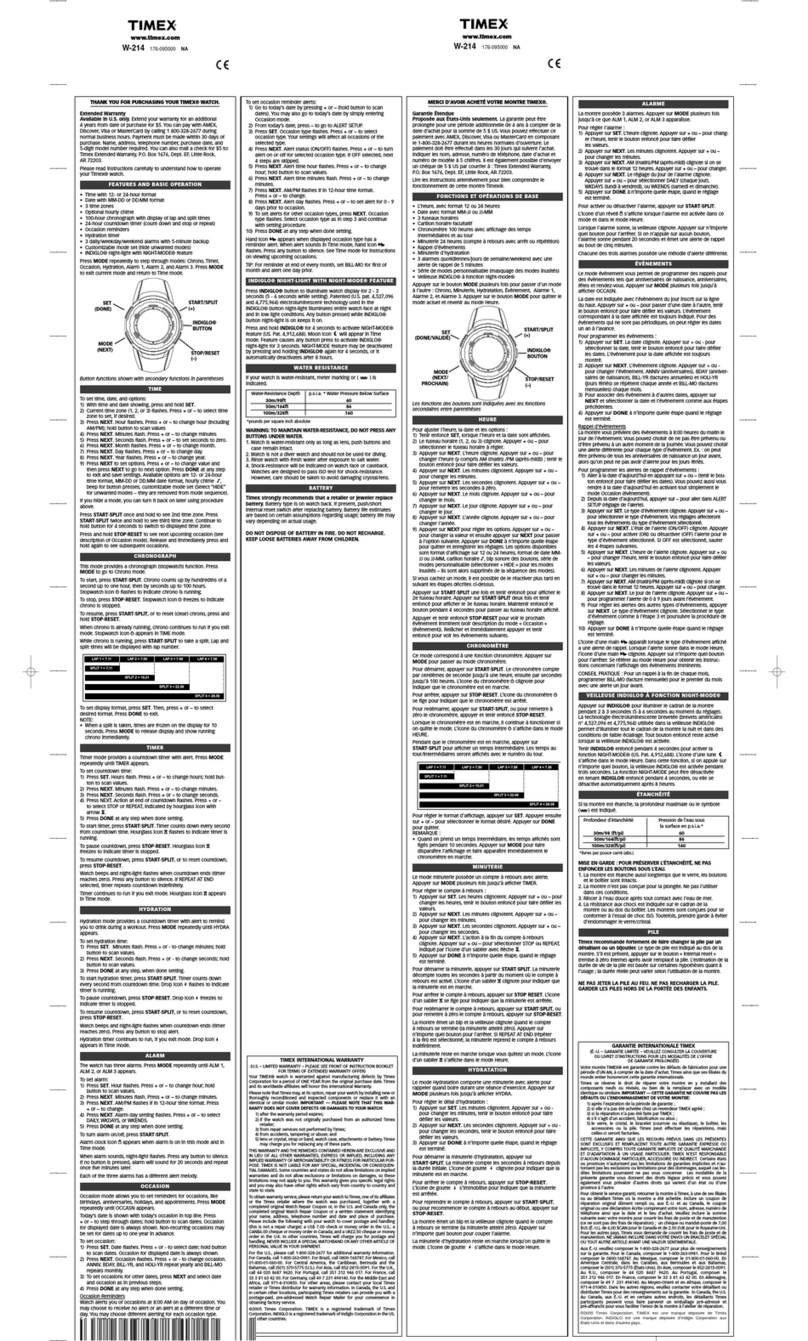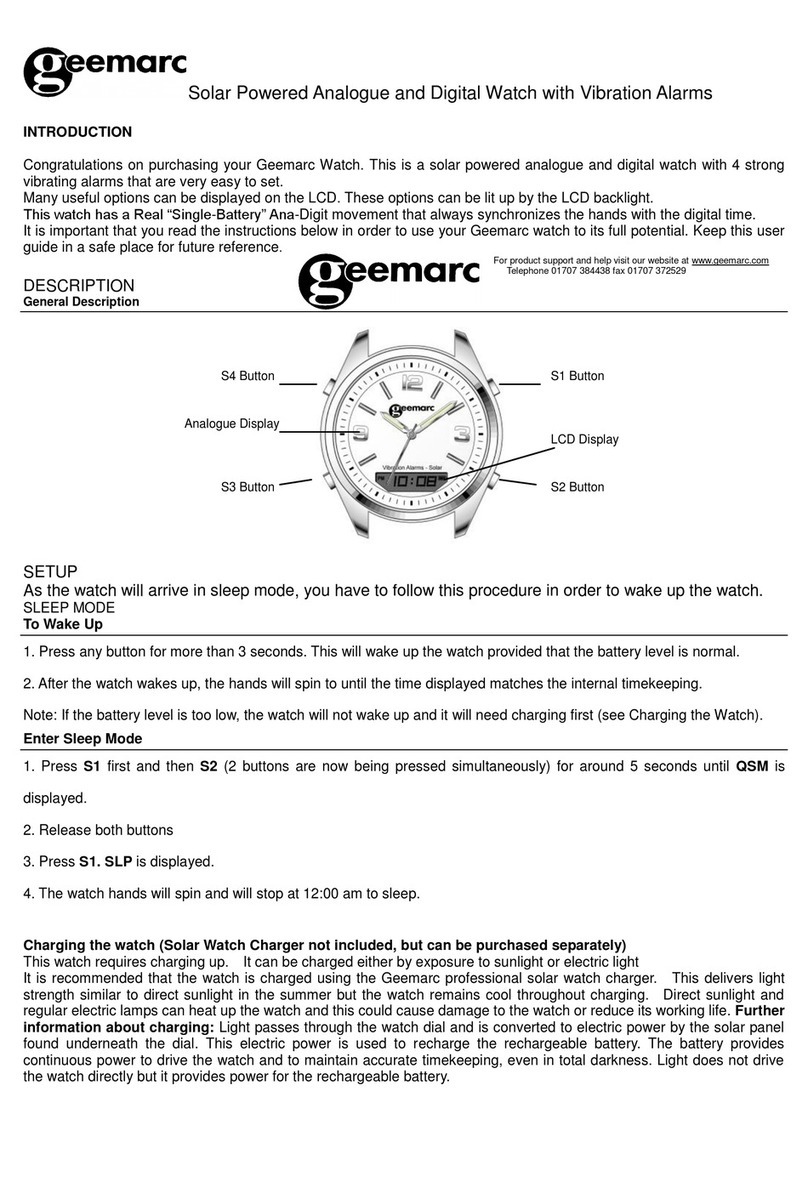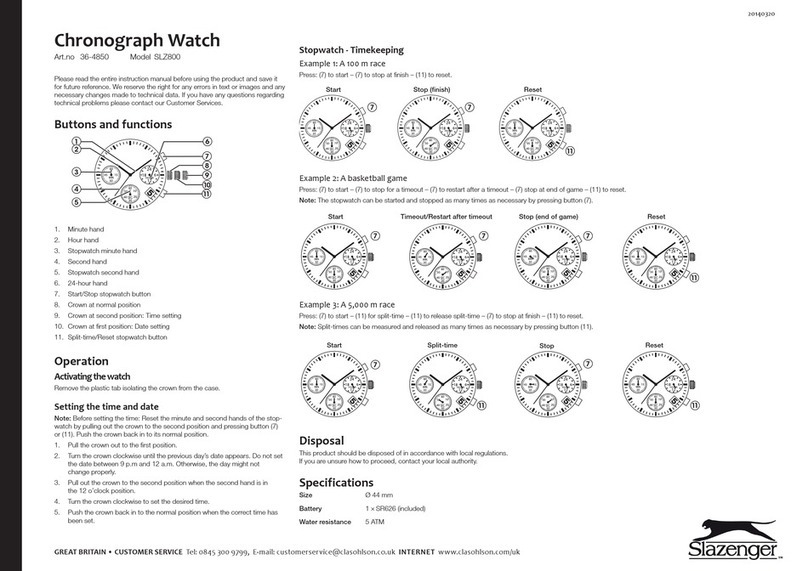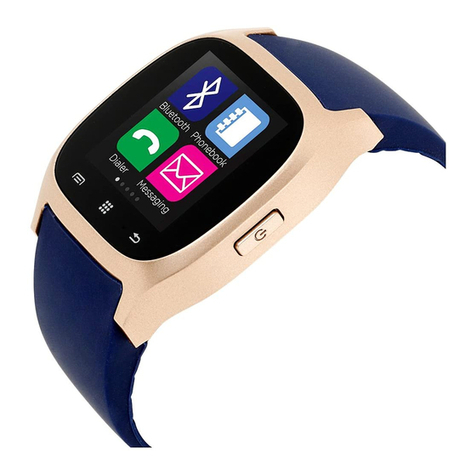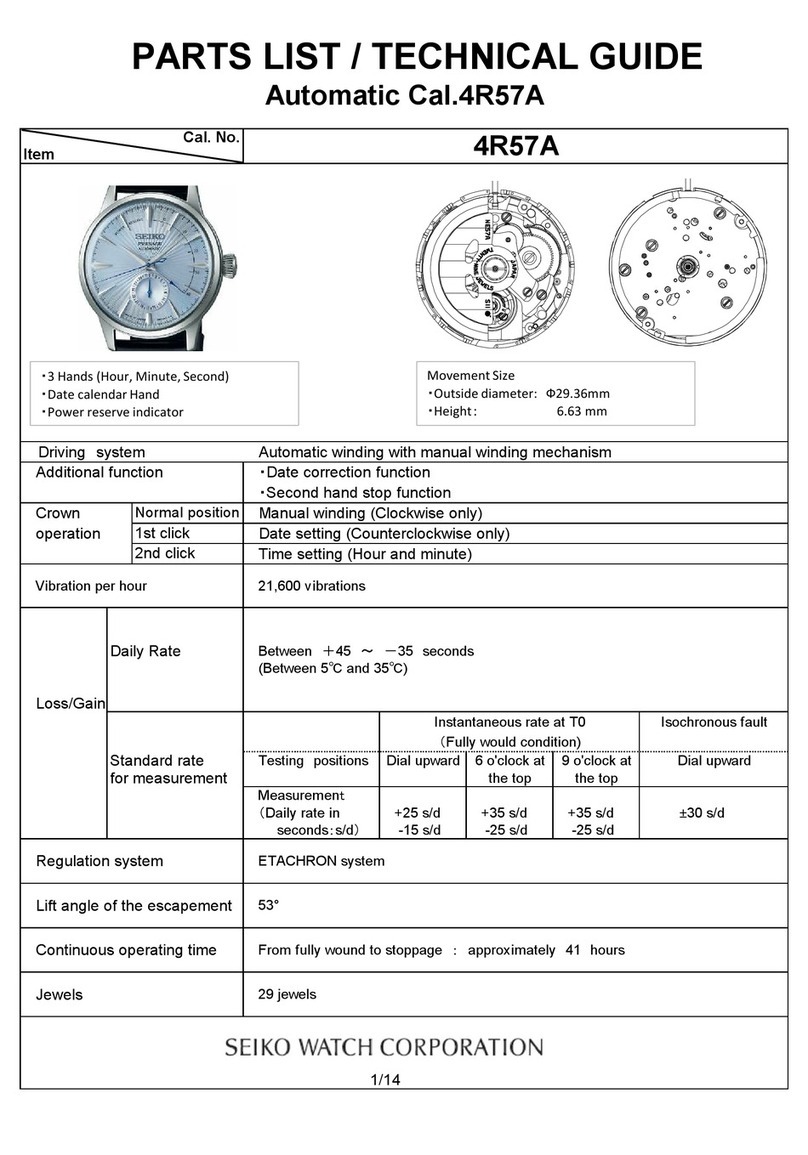
USER’S GUIDE 2510
2
About Auto Receive
When auto receive is turned on, the watch automatically starts to receive the
time calibration signal when the time in the Timekeeping Mode reaches 2:00
AM, 4:00 AM and 6:00 AM each day (calibration times).
Note
•The auto receive operation is performed only if the watch is in the Timekeeping
or World Time Mode when one of the calibration times is reached.
It is not performed if a calibration time is reached while you are making
settings (while settings are flashing on the display), while an alarm is
sounding, or while a silent alert operation is being performed.
•Auto receipt of the calibration signal is designed to be performed early in the
morning, while you sleep (provided that the Timekeeping Mode time is set
correctly). Before going to bed for the night, remove the watch from your
wrist, and put it in a location where it can easily receive the signal.
•The receive indicator indicates that either the 2:00 AM, 4:00 AM, or 6:00 AM
calibration signal reception was successful. Note, however, that the receive
indicator is cleared from the display at 3:00 AM each day.
•If you do not see the receive indicator except for the above reason, it means
there was some problem with the calibration reception operation. Either
perform reception manually, or make sure the watch is set up properly to
receive the time calibration signal for the next automatic reception time.
•When auto receive is turned on, the watch receives the calibration signal for
two to six minutes each day when the Timekeeping Mode time reaches 2:00
AM, 4:00 AM and 6:00 AM. Do not operate any of the watch’s buttons within
six minutes prior to or following the calibration times. Doing so can interfere
with correct calibration.
•Remember that reception of the calibration signal depends on the time kept
in the Timekeeping Mode. The receive operation will be performed whenever
the display shows 2:00 AM, 4:00 AM and 6:00 AM, regardless of whether or
not the Timekeeping Mode time is actually the correct time.
•When two or three receptions are successful, the watch uses the data of the
last reception for calibration. When only one reception is successful, the
watch uses the data of the successful reception.
To turn auto receive on and off
1.In the Timekeeping Mode, press B. This causes
the current auto receive on/off setting (the receive
indicator) to flash, which indicates the setting
screen.
2.Press Dto toggle auto receive on (ON) and off
(OFF).
3.Press Bto exit the setting screen.
l
l
l
l
l
l
l
l
l
l
l
l
l
l
l
l
l
l
l
l
l
l
l
l
l
l
l
l
l
l
l
l
l
l
l
l
l
l
l
l
l
l
l
l
l
l
l
l
l
l
l
l
l
l
l
l
l
l
Auto
Receive
Seconds
DST
Frequency 12/24-Hour
Format
City Code
Month Year Minutes Hour
Day
Setting the Time and Date Manually
Make sure you select your Home City code (the city code whose time and date
you are setting) before change the current time and date settings. World Time
Mode times are all displayed in accordance with the Timekeeping Mode
settings. Because of this, World Time Mode times will not be correct if you do
not select the proper Home City code before setting the time and date in the
Timekeeping Mode.
To set the current time and date manually
1.In the Timekeeping Mode, press B. This causes
the current auto receive on/off setting (the receive
indicator) to flash, which indicates the setting
screen.
2.Press Cto move the flashing in the sequence
shown below to select other settings.
3. When the setting you want to change is flashing, use Aand/or Dto
change it as described below.
ScreenSetting
Auto Receive
Frequency
City code
DST
12/24-Hour
format
Hour, Minutes
Seconds
Month, Day, Year
Button Operations
Press Dto toggle auto receive on and off.
When TYO (Tokyo) is selected as the city
code, press Dto toggle the calibration
signal reception frequency among Auto
(FREQ. AT), 40KHz (FREQ. 40) and 60KHz
(FREQ. 60). Note that frequency selection is
available for the TYO city code only.
Use D(+) and A(–) to change the setting.
Press Dto toggle between Daylight Saving
Time (ON) and standard time (OFF).
•Pressing Dperforms a different operation
when HKG, TYO, SEL, NYC, CHI, DEN,
LAX, ANC or HNL is selected as Home
City Code. See “Auto Summer Time (DST)
Switching”.
Press Dto toggle between 12-hour (12H)
and 24-hour (24H) timekeeping.
Use D(+) and A(–) to change the
setting.
Press Dto reset the seconds to 00.
Use D(+) and A(–) to change the
setting.
4. Press Bto exit the setting screen.
•The auto receive setting is used for time calibration signal reception only. See
“About Auto Receive” for details.
•See “City Code Table” at the back of this manual for a complete list of
available city codes.
•Resetting the seconds to 00 while the current count is in the range of 30 to
59 causes the minutes to be increased by 1. In the range of 00 to 29, the
seconds are reset to 00 without changing the minutes.
World Time
World Time shows the current time in 30 cities (29
time zones) around the world.
•For full information on city codes, see the “City
Code Table” at the back of this manual.
•The current time for all city codes in the World Time
Mode is calculated in accordance with the
Greenwich Mean Time (GMT) differential for each
city, based on the your Home City time setting.
•All of the operations in this section are performed in
the World Time Mode, which you enter by pressing
C.
Current time in the
selected city code
City code
GMT
differential
To view the time in another city code
While in the World Time Mode, press Dto scroll through the city codes (time
zones) to the east or Ato scroll to the west.
•If the current time shown for a city is wrong, check your Timekeeping Mode
time and Home City settings and make the necessary changes.
To toggle a city code time between standard time and Daylight Saving Time
1.In the World Time Mode, use Aand Dto display
the city code (time zone) whose standard time/
Daylight Saving Time setting you want to change.
2.Press Bto toggle Daylight Saving Time (DST
displayed) and standard time (DST not displayed).
•The DST indicator is on the display whenever you
display a city code for which Daylight Saving Time
is turned on.
•Note that the DST/Standard Time setting affects
only the currently displayed city code. Other city
codes are not affected.
•Daylight Saving Time (DST) advances the time setting by one hour from
Standard Time. Remember that the not all countries or even local areas use
Daylight Saving Time.
•The watch will perform a signal receive operation even if it is in the World
Time Mode when a calibration time is reached. If this happens, the World
Time Mode time settings will be adjusted in accordance with the Timekeeping
Mode’s Home City code time.
To display Alarm Mode screen
In the Alarm Mode, use Dto cycle through the alarm screens as shown
below.
•The following alarm screen names appear in the
center of the display to indicate the alarm whose
screen is currently displayed.
ALARM1 through ALARM4: One-time alarm screen
SNOOZE: Snooze alarm screen
SIGNAL: Hourly Time Signal screen
•The currently displayed alarm screen is also
indicated by the alarm name indicators along the
bottom left of the watch's display.
ALARM1 ALARM2 ALARM3 ALARM4 SNOOZE SIGNAL
Alarm1
Alarm2
Alarm3
Alarm4
Snooze
Alarms
The Alarm Mode gives you a choice of four one-time
alarms and one snooze alarm. You can select either
an audible beeper or flashing silent alert to let you
know when any of the alarm times is reached.
You can also input reminder text that appears when
the alarm time is reached.
Also use the Alarm Mode to turn the Hourly Time
Signal on and off.
•All of the operations in this section are performed in
the Alarm Mode, which you enter by pressing C.
Alarm time
Alarm on indicator
Alarm screen name/
Reminder text
Alarm name
indicator
To set an alarm
1.In the Alarm Mode, use Dto select the alarm
whose time you want to set.
2.Press Band the hour setting of the alarm time
starts to flash, which indicates the setting screen.
•Pressing Aand Dat the same time resets the
alarm time to 12:00 AM, and clears the reminder
text in the upper part of the display (if there is any).
3.Press Cto move the flashing in the sequence
shown below to select other settings.
•Selecting the text causes the text input cursor to appear. You can input up
to eight characters of reminder text for each alarm.
•There are eight spaces in the text, so you have to press Ceight times to
move to the Hour setting.
4. When the setting you want to change is selected, use Aand Dto change it.
•While the hour or minute setting is flashing, use D(+) and A(–) to
change it.
•When setting the alarm time using the 12-hour format, take care to set the
time correctly as a.m. (no indicator) or p.m. (Pindicator).
•When inputting text, use Aand Dto cycle through characters at the
current cursor location, and Cto move the cursor to the right. See
“Inputting Text” for more information.
5. Press Bto exit the setting screen.
•If you input reminder text, the text appears in place of the alarm screen name
when you exit the setting screen.
•If the reminder text has more than six characters, it will scroll from right to left
whenever it is displayed.
MinutesHour Te x t
l
l
l
l
l
l
l
l
l
l
l
l
l
l
l
